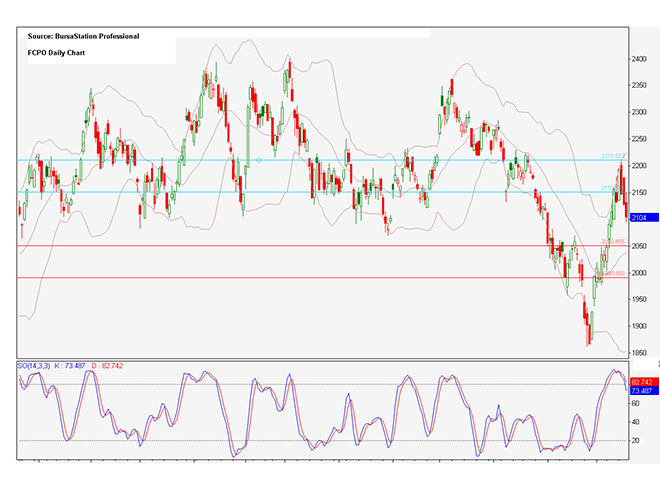 Malaysian palm oil futures edged lower on Friday to 2,104, as the release of export data by cargo surveyors next week pushed traders into cautious buying ahead of the weekend. However a weakening ringgit supported the price.
Malaysian palm oil futures edged lower on Friday to 2,104, as the release of export data by cargo surveyors next week pushed traders into cautious buying ahead of the weekend. However a weakening ringgit supported the price.
Future Crude Palm Oil (FCPO) benchmark December 2015 contract settled at 2,102 on Friday, down 28 points or 1.33 per cent from 2,132 last Friday.
Trading volume increased to 166,907 contracts from 133,584 contracts from last Monday to Thursday, not including Wednesday.
Open interest based decreased to 587,759 contracts from 613,987 contracts from last Monday to Thursday, not including Wednesday.
Intertek Testing Services (ITS) reported that exports of Malaysia’s palm oil products during September 1 to 15 increased 6.9 per cent to 765,322 tonnes compared with 715,922 tonnes during August 1 to 15.
Societe Generale de Surveillance’s (SGS) report showed that Malaysia’s palm oil exports during September 1 to 15 increased 3.6 per cent to 756,429 tonnes compared with 729,834
Overall, demand rose marginally from China and the US while demand fell from the EU, and India. Pakistan did not import any palm oil products for the first 15 days of September.
Spot ringgit strengthened on Friday to 4.203, as the US Federal Reserve left interest rates unchanged, while sustained concerns over slowing global growth clouded their outlook.
A government circular showed that Malaysia, the world’s second-largest palm grower after Indonesia, will keep its crude palm oil export tax for October at zero per cent, extending duty-free exports that began in May.
A haze that has engulfed parts of the world’s biggest oil palm-growing region in Southeast Asia, threatens to delay fruit growth and disrupt harvesting during the peak production season.
Palm oil production might decline 10 to 20 per cent in the affected areas, according to Purushothaman Kumaran, chief financial officer at IJM Plantations Bhd.
A prolonged haze amid the strongest El Nino in two decades might hurt oil palms in the coming months and could potentially support prices which slumped to a six-year low in August.
On Monday, the price rose, hitting a more than seven week high, due to speculative buying ahead of export data and firmer soybean prices.
On Tuesday and Thursday, the price fell, retreating after touching the highest in more than seven weeks, due to technical correction following a sharp rally over the past three weeks, coupled with a strengthening ringgit.
On Friday, the price declined for a third consecutive day, while touching the lowest in more than a week, as the release of export data this coming week pushed traders into cautious buying ahead of the weekend. However, a rising ringgit capped losses.
Technical analysis
According to the weekly FCPO chart, the price opened below the middle Bollinger band and tested the middle Bollinger band and psychological barrier at 2,200. By the end of the week, the price closed below the middle Bollinger band, while testing the psychological barrier at 2,100, closing above. A bearish hanging man candlestick was formed, indicating the potential to test the psychological barrier at 2,000 in near term.
According to the daily FCPO chart, on Monday, the price opened below the top Bollinger band, while the SO remained in overbought territory.
By the later session, the price tested the top Bollinger band, closing below, while closing above resistance the level at 2,170. Daily volume was above the normal daily average volume. A bullish marubuzo candlestick was formed, indicating potential to break above the psychological barrier 2,200 in the near term.
On Tuesday, the price opened below the top Bollinger band and above the psychological barrier at 2,200. An upside gap was formed from 2,190 to 2,200, which might be covered in the near term or indicate a potential to break through the psychological barrier at 2,200.
By the later session, the previous gap was covered, while the price tested support level at 2,170, closing below.
On Thursday, the price opened below the top Bollinger band and above the resistance level at 2,170.
An upside gap was formed from 2,150 to 2,180, which could be covered in the near term or signal potential to retest the psychological barrier at 2,200. By the later session, the gap was covered, while the price tested the resistance level at 2,170, closing below.
Daily volume more than doubled the normal daily average. A bearish hanging man candlestick was formed, indicating a potential for the start of a downtrend towards the psychological barrier at 2,100.
On Friday, the price opened below the top Bollinger band and resistance level 2,170, while the SO exit overbought territory. By the later session, the price tested the psychological barrier 2,100, closing above.
In the coming week, the price has the potential to range between 2,150 and 2,300. Resistance lines will be placed at 2,150 and 2,210, while support lines will be positioned at 2,050 and 1,990, these levels will be observed this coming week.
Major fundamental news this coming week:
ITS and SGS report released on the September 21 (Monday) and September 25 (Friday). Malaysia Public Holiday and Hari Raya Haji on the September 24 (Thursday).
Oriental Pacific Futures (OPF) is a Trading Participant and Clearing Participant of Bursa Malaysia Derivatives. You may reach us at www.opf.com.my. Disclaimer: This article is written for general information only. The writers, publishers and OPF will not be held liable for any damage or trading losses that result from the use of this article.
